AMD's Sempron 3300+: 90nm Budget Computing
by Anand Lal Shimpi on April 18, 2005 2:10 AM EST- Posted in
- CPUs
Workstation Applications
SPECviewperf 8
For our next set of professional application benchmarks, we turn to SPECviewperf 8. SPECviewperf is a collection of application traces taken from some of the most popular professional applications, and compiled together in a single set of benchmarks used to estimate performance in the various applications that the benchmark is used to model. With version 8, SPEC has significantly improved the quality of the benchmark, making it even more of a real world indicator of performance.
We have included SPEC's official description of each one of the 8 tests in the suite.
Not too surprising is the strong performance of the Sempron here; the chip's on-die memory controller ensures very good performance in all of the SPECviewperf tests.
3dsmax Viewset (3dsmax-03)
"The 3dsmax-03 viewset was created from traces of the graphics workload generated by 3ds max 3.1. To ensure a common comparison point, the OpenGL plug-in driver from Discreet was used during tracing.
The models for this viewset came from the SPECapc 3ds max 3.1 benchmark. Each model was measured with two different lighting models to reflect a range of potential 3ds max users. The high-complexity model uses five to seven positional lights as defined by the SPECapc benchmark and reflects how a high-end user would work with 3ds max. The medium-complexity lighting models use two positional lights, a more common lighting environment.
The viewset is based on a trace of the running application and includes all the state changes found during normal 3ds max operation. Immediate-mode OpenGL calls are used to transfer data to the graphics subsystem."
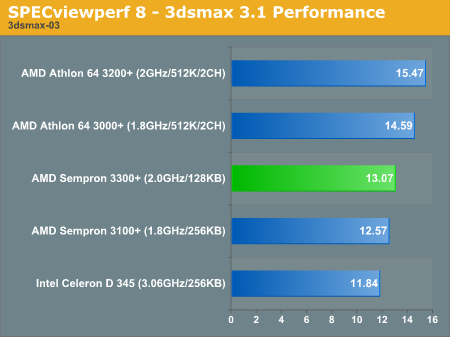
CATIA Viewset (catia-01)
"The catia-01 viewset was created from traces of the graphics workload generated by the CATIATM V5R12 application from Dassault Systems.
Three models are measured using various modes in CATIA. Phil Harris of LionHeart Solutions, developer of CATBench2003, supplied SPEC/GPC with the models used to measure the CATIA application. The models are courtesy of CATBench2003 and CATIA Community.
The car model contains more than two million points. SPECviewperf replicates the geometry represented by the smaller engine block and submarine models to increase complexity and decrease frame rates. After replication, these models contain 1.2 million vertices (engine block) and 1.8 million vertices (submarine).
State changes as made by the application are included throughout the rendering of the model, including matrix, material, light and line-stipple changes. All state changes are derived from a trace of the running application. The state changes put considerably more stress on graphics subsystems than the simple geometry dumps found in older SPECviewperf viewsets.
Mirroring the application, draw arrays are used for some tests and immediate mode used for others."
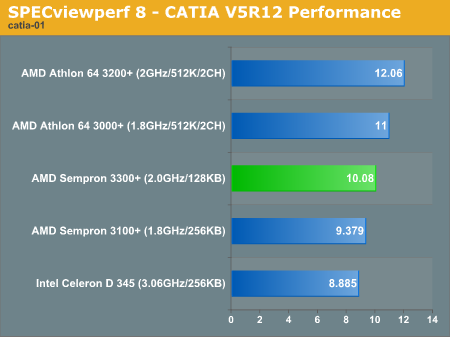
Lightscape Viewset (light-07)
"The light-07 viewset was created from traces of the graphics workload generated by the Lightscape Visualization System from Discreet Logic. Lightscape combines proprietary radiosity algorithms with a physically based lighting interface.
The most significant feature of Lightscape is its ability to simulate global illumination effects accurately by precalculating the diffuse energy distribution in an environment and storing the lighting distribution as part of the 3D model. The resulting lighting "mesh" can then be rapidly displayed."
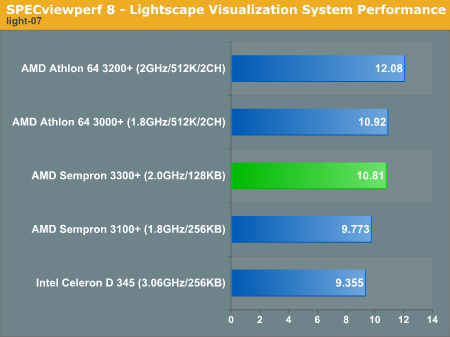
Maya Viewset (maya-01)
"The maya-01 viewset was created from traces of the graphics workload generated by the Maya V5 application from Alias.
The models used in the tests were contributed by artists at NVIDIA. Various modes in the Maya application are measured.
State changes as made by the application are included throughout the rendering of the model, including matrix, material, light and line-stipple changes. All state changes are derived from a trace of the running application. The state changes put considerably more stress on graphics subsystems than the simple geometry dumps found in older viewsets.
As in the Maya V5 application, array element is used to transfer data through the OpenGL API."
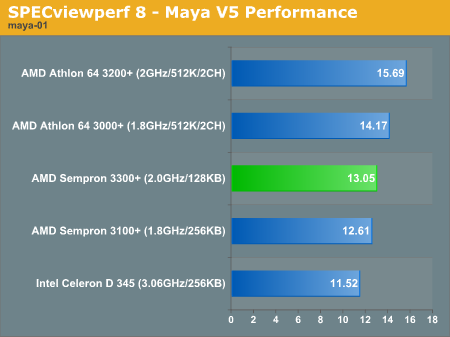
Pro/ENGINEER (proe-03)
"The proe-03 viewset was created from traces of the graphics workload generated by the Pro/ENGINEER 2001TM application from PTC.
Two models and three rendering modes are measured during the test. PTC contributed the models to SPEC for use in measurement of the Pro/ENGINEER application. The first of the models, the PTC World Car, represents a large-model workload composed of 3.9 to 5.9 million vertices. This model is measured in shaded, hidden-line removal, and wireframe modes. The wireframe workloads are measured both in normal and antialiased mode. The second model is a copier. It is a medium-sized model made up of 485,000 to 1.6 million vertices. Shaded and hidden-line-removal modes were measured for this model.
This viewset includes state changes as made by the application throughout the rendering of the model, including matrix, material, light and line-stipple changes. The PTC World Car shaded frames include more than 100MB of state and vertex information per frame. All state changes are derived from a trace of the running application. The state changes put considerably more stress on graphics subsystems than the simple geometry dumps found in older viewsets.
Mirroring the application, draw arrays are used for the shaded tests and immediate mode is used for the wireframe. The gradient background used by the Pro/E application is also included to better model the application workload."
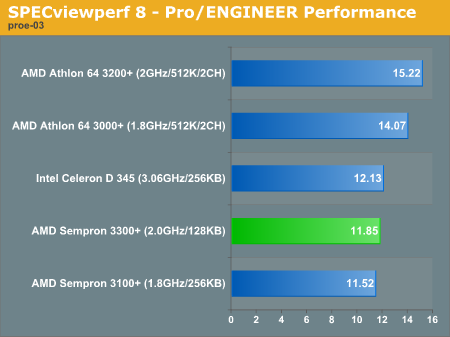
SolidWorks Viewset (sw-01)
"The sw-01 viewset was created from traces of the graphics workload generated by the Solidworks 2004 application from Dassault Systemes.
The model and workloads used were contributed by Solidworks as part of the SPECapc for SolidWorks 2004 benchmark.
State changes as made by the application are included throughout the rendering of the model, including matrix, material, light and line-stipple changes. All state changes are derived from a trace of the running application. The state changes put considerably more stress on graphics subsystems than the simple geometry dumps found in older viewsets.
Mirroring the application, draw arrays are used for some tests and immediate mode used for others."

Unigraphics (ugs-04)
"The ugs-04 viewset was created from traces of the graphics workload generated by Unigraphics V17.
The engine model used was taken from the SPECapc for Unigraphics V17 application benchmark. Three rendering modes are measured -- shaded, shaded with transparency, and wireframe. The wireframe workloads are measured both in normal and anti-alised mode. All tests are repeated twice, rotating once in the center of the screen and then moving about the frame to measure clipping performance.
The viewset is based on a trace of the running application and includes all the state changes found during normal Unigraphics operation. As with the application, OpenGL display lists are used to transfer data to the graphics subsystem. Thousands of display lists of varying sizes go into generating each frame of the model.
To increase model size and complexity, SPECviewperf 8.0 replicates the model two times more than the previous ugs-03 test."
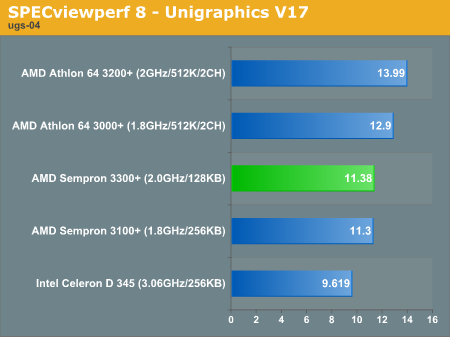










53 Comments
View All Comments
snorre - Friday, June 24, 2005 - link
It seems like AMD also has enabled 64-bit support in this CPU:http://finance.messages.yahoo.com/bbs?.mm=FN&a...
Even better value then I guess.
snorre - Friday, June 24, 2005 - link
Tbuch - Sunday, June 5, 2005 - link
In a time where the Processors are named with a lot of Letter addition Anandtech (and others) must be very caryfully to use these letters. You have been using a Intel 915P Motherboard which is a Socket 775 bord - therefor the Celeron processor you have tested must be a Celeron D 345J (with a"J" addition) and not "only" a 345. Am I right?johnsonx - Friday, April 22, 2005 - link
Interesting... the board's BIOS claims Cool'n'quiet support, and I loaded the latest processor driver from AMD that claims Cool'n'Quiet support for Sempron (same one I use on my own A64 2800+), but I couldn't get the Cool'n'Quiet/PowerNow dashboard demo to run (claimed no supported processor), nor could I see any other sign that it was working, like a low processor speed report in System Properties.a mystery...
(ok, so this is a bit off topic, but at least we are still talking about Semprons)
Rand - Friday, April 22, 2005 - link
I built a system around a Sempron 2600+ (S754) a few weeks ago, Cool n' Quiet worked fine on the MSI K8T Neo-FSR.Stock VCore is 1.4V, it dropped to 1.0V and 1GHz at minimum.
johnsonx - Wednesday, April 20, 2005 - link
#47 - you may or may not be right that only 1.6Ghz semprons don't have CnQ support, but it isn't because of an 8x multiplier limitation. My A64 2800+ drops to 989Mhz on CnQ (I'm guessing that's actually supposed to be 1.0Ghz, but my mainboard's clock is a touch low). That implies a 5x multiplier. Either way, it's clear a 1.8Ghz CPU can drop to 1.0Ghz, so why can't a 1.6Ghz one do it?It'd be nice if AMD would make this clear somewhere - if CnQ is a desireable feature, then why hide which CPU's have it and which don't?
(actually disabling it on ANY cpu is stupid in the first place, but again, AMD doesn't check with me on what I think is stupid)
Oh, BTW, to answer your other question, CnQ drops my A64 2800+ to 1.0v, and as far as I can recall the Sempron 2600+ runs at 1.4v. I'll look when I setup one of them later today (they're in boxes in the customer's office now).
Visual - Wednesday, April 20, 2005 - link
in regards to CnQ on the semprons - it is available to all semprons except the 1.6GHz models, as they are already at 8x multi by default (and CnQ lowers the multi, but it cant get any lower than 8x)I wanna know if CnQ lowers the voltages and by how much.. and if the 1.6GHz semprons come at the lower voltages by default or they are at 1.4v too... but yeah, this is quite out of the topic here. sorry.
Andyvan - Tuesday, April 19, 2005 - link
I'm curious about the tests in which the Sempron out-performed the Athlon 64 3200. Both were running at the same clock speed, and the Sempron has 1/4 the cache.Is this due to SSE3 support?
-- Andyvan
Jep4444 - Tuesday, April 19, 2005 - link
the XP 3200+ has been discontinued for quite some time but the A64 2800+ is still in production hence why its a better comparisonRav3n - Tuesday, April 19, 2005 - link
I would like to have seen a comparison with the Athlon XP 3200+ as well... even though that is just adding yet an additional platform.